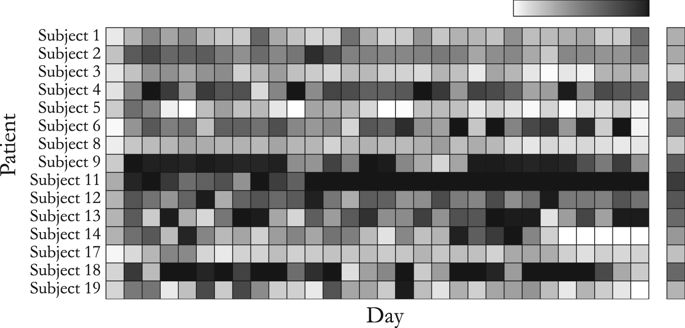npj Schizophrenia ( IF 5.4 ) Pub Date : 2017-10-16 , DOI: 10.1038/s41537-017-0038-0 Patrick Staples , John Torous , Ian Barnett , Kenzie Carlson , Luis Sandoval , Matcheri Keshavan , Jukka-Pekka Onnela

|
Sleep abnormalities are considered an important feature of schizophrenia, yet convenient and reliable sleep monitoring remains a challenge. Smartphones offer a novel solution to capture both self-reported and objective measures of sleep in schizophrenia. In this three-month observational study, 17 subjects with a diagnosis of schizophrenia currently in treatment downloaded Beiwe, a platform for digital phenotyping, on their personal Apple or Android smartphones. Subjects were given tri-weekly ecological momentary assessments (EMAs) on their own smartphones, and passive data including accelerometer, GPS, screen use, and anonymized call and text message logs was continuously collected. We compare the in-clinic assessment of sleep quality, assessed with the Pittsburgh Sleep Questionnaire Inventory (PSQI), to EMAs, as well as sleep estimates based on passively collected accelerometer data. EMAs and passive data classified 85% (11/13) of subjects as exhibiting high or low sleep quality compared to the in-clinic assessments among subjects who completed at least one in-person PSQI. Phone-based accelerometer data used to infer sleep duration was moderately correlated with subject self-assessment of sleep duration (r = 0.69, 95% CI 0.23–0.90). Active and passive phone data predicts concurrent PSQI scores for all subjects with mean average error of 0.75 and future PSQI scores with a mean average error of 1.9, with scores ranging from 0–14. These results suggest sleep monitoring via personal smartphones is feasible for subjects with schizophrenia in a scalable and affordable manner.
中文翻译:

精神分裂症队列中被动和主动睡眠估计的比较
睡眠异常被认为是精神分裂症的重要特征,但是方便,可靠的睡眠监测仍然是一个挑战。智能手机提供了一种新颖的解决方案,可捕获精神分裂症患者的自我报告和客观睡眠指标。在这个为期三个月的观察性研究中,目前正在接受治疗的17位被诊断为精神分裂症的受试者在其个人Apple或Android智能手机上下载了数字表型平台Beiwe。受试者在自己的智能手机上每三周进行一次生态瞬时评估(EMA),并不断收集包括加速度计,GPS,屏幕使用以及匿名呼叫和文本消息日志在内的被动数据。我们将根据匹兹堡睡眠问卷调查表(PSQI)进行的睡眠质量临床评估与EMA进行比较,以及基于被动收集的加速度计数据的睡眠估计。与至少完成一个亲自PSQI的受试者的临床评估相比,EMA和被动数据将85%(11/13)的受试者表现为睡眠质量高或低。用于推断睡眠时间的基于电话的加速度计数据与受试者对睡眠时间的自我评估有中等程度的相关性(r = 0.69,95%CI 0.23–0.90)。主动和被动电话数据可预测所有受试者的并发PSQI分数,平均平均误差为0.75,将来的PSQI分数,平均平均误差为1.9,分数范围为0–14。这些结果表明,通过个人智能手机进行睡眠监测对于精神分裂症患者而言是可行的,并且具有可扩展性和可负担性。



























 京公网安备 11010802027423号
京公网安备 11010802027423号